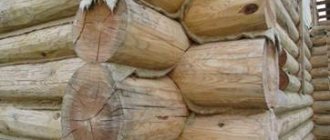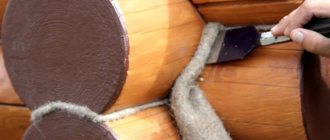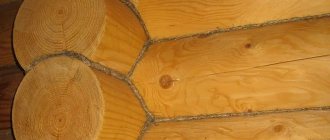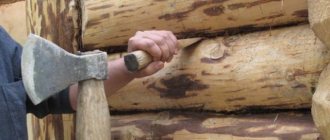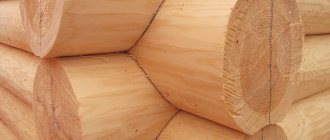The caulking of the log house provides reliable insulation of the house for the entire period of its operation. This operation is no less important than the construction of a log house; if you treat it formally, you can end up with a cold, uncomfortable and drafty house.
Unlike brick and concrete, wood is a special building material; wood is sensitive to the conditions in which it is located. Properly caulking a wooden house means creating normal conditions for construction wood and ensuring the longevity of the structure. In addition to solving problems of insulation, caulking protects wood from excess moisture and dampness, rotting, damage by microorganisms and insects.
Wooden houses are traditionally caulked with materials of natural origin; one of the most popular is insulation made from fibers of the jute plant. In wooden house construction, insulation made from this plant, exotic for Europe and America, confidently displaces other materials; jute is widely used by Canadian and Scandinavian builders.
Why choose jute
The reason for the popularity of jute fibers is their low price and good performance; on the Russian market, jute competes with traditional Russian flax. When the question arises: how to caulk a house made of timber, preference is increasingly given to jute. Cottages, economy class residential buildings, bathhouses and outbuildings are insulated using jute.
In the countries of South Asia, three “harvests” of jute are obtained from one plot per year with a yield of about 2 tons per hectare; Asian producers are able to fully satisfy the needs of the world market for this product; the advantages of jute material include:
- Environmentally friendly, fibers do not split and do not form dispersed dust,
- The fibrous mass is homogeneous, does not cake,
- Jute tape is compressed to 1-2 mm without disturbing the geometry,
- Jute insulation is hygroscopic, protects the log house from excess moisture,
- Jute can be used to caulk houses made of logs, beams, profiled and edged timber.
As a disadvantage, it is noted that wet jute mass can create a favorable environment for microorganisms and insects. To eliminate this drawback, manufacturers use preservative and antiseptic impregnations; you should pay attention to this when purchasing material.
Depending on the density, jute insulation is divided into tow tape, batting and felt. The material is rigid and elastic, tends to maintain its original shape, which requires attention and certain skills when using it.
Which sealant for cracks is better to choose?
Lnovatin
In order for log houses to preserve the internal microclimate, retain heat and keep out moisture and cold, they need to be specially treated - caulked, that is, plug the cracks between the logs. When building housing, wood is placed on moss for better adhesion, but this is not enough to plug all the holes between the building materials. When drying, additional cracks form in the logs. Therefore, it is necessary to caulk the log house not only immediately during construction, but also a couple of years after construction, when the logs are completely dry and all unnecessary cracks come out.
It is very easy to caulk a log house with your own hands, using natural materials and simple tools. Common materials for log caulking are:
- flax wool;
- wool felt;
- tow;
- jute.
They have their advantages and disadvantages, knowing which you can choose the most suitable material.
Flax wool is a product of crushing and pressing flax. The material prevents the logs from rotting, but is short-lived. Wool felt is warm, but crumbly and loose. Therefore, moisture easily penetrates through the felt, as a result of which the logs are easily covered with rot. Tow can also accumulate excess moisture and cause logs to rot.
Jute is soft wood fibers gathered into a bundle. It is produced from shrubs of the linden family, growing in Asia. The wood product is the most modern and durable material compared to its plant and animal counterparts. Jute fibers are stronger than fishing line and fit together tightly enough to prevent excess moisture from entering the house.
Since this material is completely natural, it is absolutely harmless, does not emit toxic fumes and does not cause allergic reactions in the residents of the house. Unlike linen and felt, jute is resistant to rot and moths, and it protects logs from birds.
The main advantage of the material is its hygroscopicity. The fiber absorbs excess moisture from the logs, so the log house does not rot. In dry weather, jute releases accumulated moisture to the wood, so it does not crack. The disadvantage of jute is that it consists of wood fibers, and therefore reacts to changes in weather conditions in the same way as wood: it shrinks in dry weather and swells in wet weather.
How to properly caulk a log house with jute
A house made of lumber of natural moisture is caulked in two stages: during the construction of a log house and after its shrinkage, the first operation is called primary caulking, the second - finishing. Primary caulking is done in two steps: jute tape is laid between the crowns during the construction of the log house, after the walls are erected, the seams are processed clean. When laying jute tape between logs or beams, you must adhere to the following rules:
- The surfaces of the crown before caulking are cleaned of adhering dirt, shavings and sawdust, the jute tape is rolled out along one side of the wall, and secured every meter with a construction stapler. When laying in parts, the edges are joined end to end,
- The tape is cut along the side edge of the beam, in a log house - along the line of the laying groove,
- The dowels are driven through the jute tape, an incision is made crosswise at the puncture site,
- The operations are repeated on the next crown.
The initial finishing caulking begins after laying the walls and installing the roof; caulking begins from the bottom crown. The material is driven into the inter-crown joints to a state of elasticity using a special tool, after completing work on the first crown, move on to the second. The operation is labor-intensive and requires diligence and considerable effort. According to builders' prices, the cost of this work is up to 100 rubles per meter.
After completing the work on the outside, the operation is repeated from the inside of the house; the technology for insulating a house made of timber from the outside and inside does not differ. The time spent on caulking a one-story 8x8 house can be 5-7 days.
It is important. If you caulk each wall separately, you may encounter the following problem: each processed seam increases the inter-crown distance by 3-4 mm, a fully processed wall of a house made of 200x200 timber with a height of 16 crowns will become higher by 5-7 cm, which can lead to distortions in corner connections.
Methods of caulking
When caulking completely, jute batting is driven into the cracks using interventional crowns; the operation is performed in two ways:
- “In a stretch” - a twist-pigtail of jute batting with a diameter of 20-25 mm is driven into the crack, in this way seams with large gaps are caulked,
- “To the set” - the cracks are caulked with tape insulation 5-7 mm wide, the edges of the tape are hammered into the crack one by one, then the middle part is recessed.
The craftsmen recommend laying jute tape between the crowns with an overlap of up to 60-70 mm, the free edge is wrapped, tucked into the gap and caulked “into the set”. In difficult cases, the insulation is hammered into the stretch, and the seam is finished off as a set.
After the house has been subjected to shrinkage, the previously laid layer of insulation is deformed, the inter-crown cracks open, and at this stage of caulking the log house, the work must be done virtually all over again. During the shrinkage process, deep longitudinal cracks-sinuses will appear in the body of the beam; such cracks are caulked with flax tow and sealed with sealant; for individual cracks, thermal insulation with flax material is more effective.
Preparatory work
Impregnation of wood with antiseptic
Since jute is a durable material, there may be no need for re-caulking, which saves time and money. But still, in order for a self-made caulking to last a long time and reliably seal your home, it must be installed correctly. To do this, you need to prepare in advance, prepare your tools. You should choose jute of a width that matches the width of the gaps between the logs.
To prevent the logs from rotting and collapsing, the cracks should be properly treated before caulking. For this purpose, special wood antiseptics are used. The sealant should be placed only in dry cracks. It is best to carry out caulking in the summer, warm dry spring or autumn. The air temperature should not be below +10° C, there should be no rain. Too hot weather is also not suitable, as the logs dry out unnecessarily, which can result in overuse of jute.
Jute materials are easily torn by hand. Without using any special means, you can install the seal yourself quickly and easily. But such a finish will not have a completely aesthetic appearance, so it cannot be used for walls that carry a decorative load. To make caulked walls look neater, the pieces of insulation need to be identical and have smooth edges. To do this, the jute must be cut with a sharp knife or scissors. Therefore, the tools should be sharpened in advance.
You need to squeeze the sealant into the gap carefully, using a special metal caulk, which visually resembles a small chisel. If one is not available, it can be replaced with a thin chisel. To drive the seal into the gap, you will also need a hammer and a rubber mallet. If the gaps are small, then you can use a jute rope of small diameter. If the rope is narrow and the gaps are large, then it is better to fold it several times.
How to caulk the corners of a log house with jute
When caulking a log house, special attention is paid to the corners; this largely determines whether the house will be warm or not. The easiest way to work is with corners cut into a bowl. In this case, the oblo is part of a log or beam, the jute tape is laid on a common surface, as a result, each seam of the corner lock receives its own layer of insulation.
When chopping into a paw, the elements of the castle are caulked in different ways; in general, the principle is followed: each joint must be caulked.
Finishing caulking is done in order, simultaneously with the crowns.
What is caulk? Why do you need caulk?
Caulking is a method of sealing the cracks that form between adjacent logs with a special fibrous material.
Caulk is needed for:
- eliminating gaps between individual logs that appear as a result of wood shrinkage;
- reducing the time and amount of fuel required to heat up the steam room and maintain the required temperature in it;
- preventing condensation and drafts;
- protection of the log house from rotting and premature destruction.
How to choose a jute ribbon
Jute insulation is selected according to density, thickness and width. A high-density jute tape is laid between the crowns; when shrinking, the low-density insulation cakes more; the width is chosen according to the size of the timber; for rounded logs - according to the size of the laying groove. Experts recommend:
- Lay the edged timber with jute tape 20-25 mm thick; under pressure its thickness will be no more than 4 mm;
- For dry planed timber, use a tape 10-12 mm thick, which shrinks to 2 mm.
Intervention seams are caulked with a material of lower density; to fill cracks, jute batting with a density of 500-600 grams per square meter is used.
swamp moss
Sphagnum moss is a natural material that is not subject to rotting, hygroscopic and has good bactericidal properties. “Collecting” houses “for moss” has been common in Russia since ancient times.
The insulation of a wooden frame is carried out simultaneously with the erection of the walls: a sealant is laid in layers on each crown.
The so-called red moss was popular. In the absence of it, cuckoo flax (forest moss) was used.
Caulk and insulation of a log house with moss
Caulking Tools
The toolkit includes:
- A stackable caulk with a blunt blade for working “as a set”; it is better to have two types of tools: with a 10-centimeter blade for caulking crowns and a 2-centimeter blade for cracks;
- The road worker for laying twists “in a stretch” has a wide blade thickened towards the bottom. A semicircular notch is made along the entire length of the blade;
- Breaking caulking with a wedge-shaped blade is driven into the cracks to widen them.
The tool is made of hardwood or soft metal and has a handle that is comfortable for work. A mallet is used as a percussion instrument - a hammer with a wooden or rubber striker.
Services of professional caulkers
Entrust the caulking of your home or bathhouse to qualified specialists who will quickly and efficiently complete all the work. We employ caulkers with ten years of experience who are well aware of all the subtleties and nuances of caulking. We use high-quality and dried natural materials that meet all requirements. We work under a contract and provide quality guarantees. Our specialists will make caulking of any complexity and volume at an affordable cost. Contact us in any convenient way using the coordinates in the “Contacts” section.
Calculate the cost of painting and insulating your home right now
Select types of work:
Sandblasting Sanding with machines Warm seam Painting Additional. work
Select materials:
Ramsauer sealant Remmers sealant Gnature or Biofa oil Remmers oil Adler oil Other
Advice from the experts
Caulk with jute rope
- The walls of a house made of edged timber do not always have an attractive appearance; it is almost impossible to lay insulation between the crowns without unevenness, so it will not be possible to caulk the frame “string by thread”. You can decorate the facade using jute rope, which is laid over a layer of inter-crown insulation; the rope is secured with clapboard nails.
- After finishing caulking, it is advisable to treat the crown gaps with an antiseptic; the domestic drug “Neomid” is an effective remedy. The product provides long-term protection of insulation made from natural materials from rotting, fungus and insects. It has a liquid consistency and is applied with a brush.
- If the frame is sanded after shrinkage, finishing caulk is carried out last - after sanding of the walls is completed.
Tow
To make this natural sealant, hemp, jute, and flax are used by entangling their short hairs. The name is given to it taking into account the material that makes up the base. Tow of any composition is sold in bags, bales, and strips. For caulking small cracks, tow is the most suitable sealant.
The dignity of tow
The unique features of any tow base allow you to:
- Provide excellent properties of an insulating barrier that reliably prevents any penetration of draft, cold air, noise
- Natural bactericidal characteristics effectively prevent the formation of fungal and mold colonies and the appearance of wood-destroying bugs
- Form an environmentally friendly insulating layer
- Thanks to its tangled structure, tow does not weather and is destroyed during long-term use.
Features of the use of interventional insulation
2
- Natural insulation materials
. There are very few such materials - these are modifications of jute and flax. They are made using needle-punched technology, resulting in a woven fabric in the form of felt. Less commonly used for such purposes are moss, tow and sheep's wool. - Synthetic insulation
. There are many more similar samples, one of the most popular is polytherm. They are much more expensive than natural ones, do not burn, are highly reducible, but have low vapor permeability. If a house with caulked holes will stand for a long time without protective cladding, it is better to use artificial insulators. It is not recommended to use mineral, polyurethane wool, or isover.
